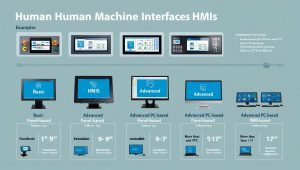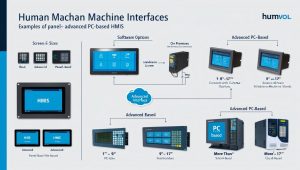The U.S. Human Machine Interface (HMI) market is experiencing a significant growth trajectory, driven by increasing automation in industries and the growing demand for advanced consumer electronics. As automation technologies revolutionize sectors like manufacturing, healthcare, and automotive, the need for intuitive and responsive interfaces between humans and machines has never been more critical. HMIs, which enable users to control machines and systems through interactive devices like touchscreens, buttons, and even voice commands, have become central to the evolving landscape of both industrial applications and consumer technologies.
Industrial Automation Driving HMI Adoption
One of the primary factors contributing to the expansion of the U.S. HMI market is the rise of industrial automation. As companies seek greater efficiency, flexibility, and productivity, there is an increasing need for user-friendly interfaces that allow operators to control complex machinery and monitor production processes in real-time. HMIs are integral to automation systems, providing seamless interaction with robotic arms, conveyor belts, and machine controllers. Industries such as automotive manufacturing, food processing, and pharmaceuticals are adopting HMI technologies to ensure smooth operations, reduce downtime, and enhance operational efficiency.
In particular, sectors like oil and gas, power generation, and mining are incorporating HMI systems to streamline plant operations and facilitate remote monitoring. The shift toward Industry 4.0, with its focus on interconnected machines and the Internet of Things (IoT), has further accelerated the demand for advanced HMI solutions. These interfaces allow workers to interact with machines through more natural and intuitive means, such as touchscreen panels, voice commands, or even gesture recognition. This advancement not only boosts productivity but also improves safety by minimizing human errors and providing real-time alerts and diagnostics.
Download PDF Brochure @ https://www.marketsandmarkets.com/pdfdownloadNew.asp?id=461

Consumer Electronics and the Push for User-Centric Interfaces
The rise of consumer electronics is another key driver behind the growth of the HMI market. As demand for smart devices and connected technologies continues to grow, consumers are expecting more advanced, user-friendly interfaces in their everyday products. From smartphones and tablets to wearable devices and home automation systems, human-machine interfaces are integral to creating seamless user experiences.
In particular, the growing popularity of voice-controlled assistants like Amazon Alexa, Google Assistant, and Apple Siri has pushed for new developments in HMI technology. Voice recognition systems have become a staple in smart homes, allowing users to control lighting, temperature, security, and entertainment systems with simple voice commands. Moreover, touch interfaces, which have long been a feature of smartphones and tablets, are increasingly being incorporated into everyday appliances, including refrigerators, washing machines, and even automobiles.
The automotive sector, too, is playing a significant role in driving the demand for advanced HMI systems. With the rise of electric vehicles (EVs), autonomous driving technologies, and connected cars, the interface between driver and vehicle is evolving rapidly. Touchscreen dashboards, heads-up displays, and gesture-based controls are becoming commonplace in modern vehicles, offering drivers a more intuitive and customizable experience. As these technologies evolve, the need for more advanced HMI systems that can provide real-time information, ensure safety, and enhance user comfort is expected to grow.
Key Trends in the U.S. HMI Market
Several key trends are shaping the future of the U.S. HMI market. First, there is a significant shift towards more advanced and intuitive interfaces. As technology progresses, users expect interfaces that not only respond to touch but also incorporate voice, gesture, and even eye-tracking capabilities. These advancements are designed to improve user engagement and make human-machine interaction more natural.
Second, the integration of artificial intelligence (AI) and machine learning (ML) with HMI systems is revolutionizing the way machines respond to human inputs. AI-enabled HMIs can learn from user behavior, adjust to preferences, and predict user intentions, resulting in smarter and more personalized experiences. For instance, in the healthcare industry, AI-powered HMIs can help doctors monitor patient health metrics and provide data-driven insights, enabling more effective decision-making.
Lastly, the adoption of augmented reality (AR) and virtual reality (VR) technologies in HMI systems is gaining traction. AR and VR can create immersive environments for operators, enabling them to interact with machines in a more intuitive and dynamic manner. This is particularly beneficial in industries like manufacturing, where technicians can use AR glasses to receive real-time instructions or troubleshoot issues without needing to leave the production floor.

Challenges and Opportunities
While the growth of the U.S. HMI market is impressive, there are still some challenges to overcome. The increasing complexity of HMI systems requires skilled operators who are well-versed in these technologies. Additionally, as HMI systems become more sophisticated, the cost of implementation and maintenance can pose a barrier for small to medium-sized enterprises (SMEs). Ensuring data security and privacy, particularly in applications involving sensitive personal or industrial information, remains another critical concern for HMI developers and users alike.
However, the opportunities for growth far outweigh the challenges. With continued advancements in technology, the U.S. HMI market is poised to expand rapidly across industries. The integration of AI, machine learning, and AR/VR will continue to enhance the functionality and user experience of HMI systems, while ongoing improvements in touch, voice, and gesture control will drive demand in consumer electronics. As industries and consumers continue to embrace smarter, more efficient systems, the role of HMIs in facilitating seamless human-machine interaction will become even more crucial.
The U.S. Human Machine Interface market is at the forefront of a digital transformation, as industries across sectors and consumers alike demand smarter, more intuitive interaction methods. With the rise of industrial automation, smart consumer electronics, and the adoption of advanced technologies like AI, AR/VR, and voice recognition, the market is set for significant expansion. As businesses and consumers alike look for more efficient, personalized, and user-friendly solutions, the demand for innovative HMI systems will only continue to grow, paving the way for a future where human-machine collaboration is more seamless and effective than ever before.
